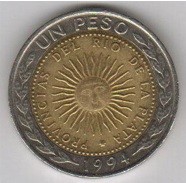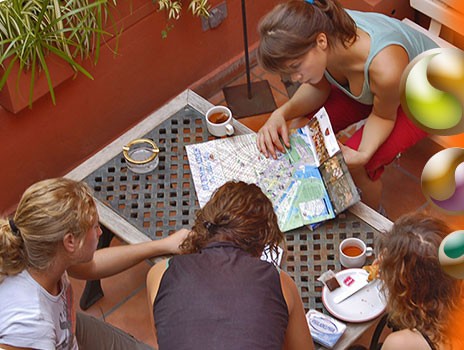Cash is still king in current-day Argentina, but thanks to new regulations that allow for a more favorable rate for credit cards this is changing, so read on.

2023/4 Update on using Credit and Debit Cards:
Regulations were put in place in late 2022, that allow for what’s called the ‘MEP rate’ for credit cards.
Those using a Visa card will receive a favorable rate. Those using Mastercard initially get charged the official rate, but receive a refund after a few days.
Lately Mastercard is less reliable, so we recommend testing on a small purchase first. People are reporting that Amex is working to receive a better rate, but it depends on your home bank.
The MEP credit card rate is just 5-10% short of the Blue Dollar Rate. Including transfer fees, the rate to using Western Union.
It does not apply to QR code payments and may not work with all credit cards, so check with your bank.
Until recently, using credit or debit cards to pay for goods or services anywhere in Argentina was for suckers, because you’d be charged the country’s much lower official exchange rate.
Now using some credit and debit cards, visitors get a much more favorable ‘MEP rate’ that is only 4-10% lower than the Blue Dollar, or black market rate.
Just like the official rate and blue dollar rate, it fluctuates daily.
Beware that paying with a QR code or Apple Pay still provides the official bank rate, so forget those payment methods.
Using Cash
Although it may sound shady, exchanging money on the black market is extremely common.
Those who want to avoid exchanging money on the black market to get the Blue Rate can now use their debit and credit cards to pay in places that take cards.
Money Transfer services are another good option.
Sometimes the rate is even higher than what you get exchanging cash, but it can be a chore.
➡ Read our post about money transfer services such as Western Union for tips.
Check our currency converter to compare the Blue Rate to the Western Union Rate in real-time ➡
We still advise bringing some cash to Argentina because many small businesses don’t take credit cards, this is especially true the fourth you get from Buenos Aires.
Some businesses charge an extra fee of 10% for foreign cars because of the fees they incur.
Argentina’s Currency & Bills
Argentina’s currency is the peso.
Although the bills are beautifully designed, Argentine pesos are a pariah currency outside of the country.
Most banks abroad won’t have any Argentine pesos to sell. If they do they will give out a very poor rate even below Argentina’s official bank rate.
The Argentine peso is indicated by the symbol ‘$‘ just like U.S. dollars.
Please note, on this website Argentine pesos are written as ‘AR$’ and U.S. dollars with ‘US$’ for clarity.
We usually use ‘US$’ to quote prices because the pesos’ inflation means prices change daily in the local currency.
The Argentine dollar was originally divided into one hundred cents, called ‘centavos’ but the centavo went out of circulation, as did the nickel, dime, quarter, and fifty cent coin.
Today the smallest coin available is a one peso coin, which is worth about US$.001. (Values fluctuate daily, so this is just an estimate. You can check out our currency converter to see the live day rate.)
There is also a two peso coin, a five peso coin and a ten peso coin.
The lowest bill now is a ten peso bill, which is worth US$.03, so it will probably be retired soon, just like the two peso bill and the five peso bill.
A new version of the five peso bill was introduced in 2015.
It had Argentina’s most beloved founding father, José de San Martín on it’s face.
Due to currency devaluation caused by inflation, the bill only lasted until 2019 — four years.
For a long time, the largest note was a $1000 bill, which was rolled out in 2018.
The AR$1,000 bill is worth less than US$3.
As you can imagine that means carrying little stacks of cash for a night out on the town.
In May 2023 a two thousand bill was introduced, but within a year there weren’t that many in circulation.
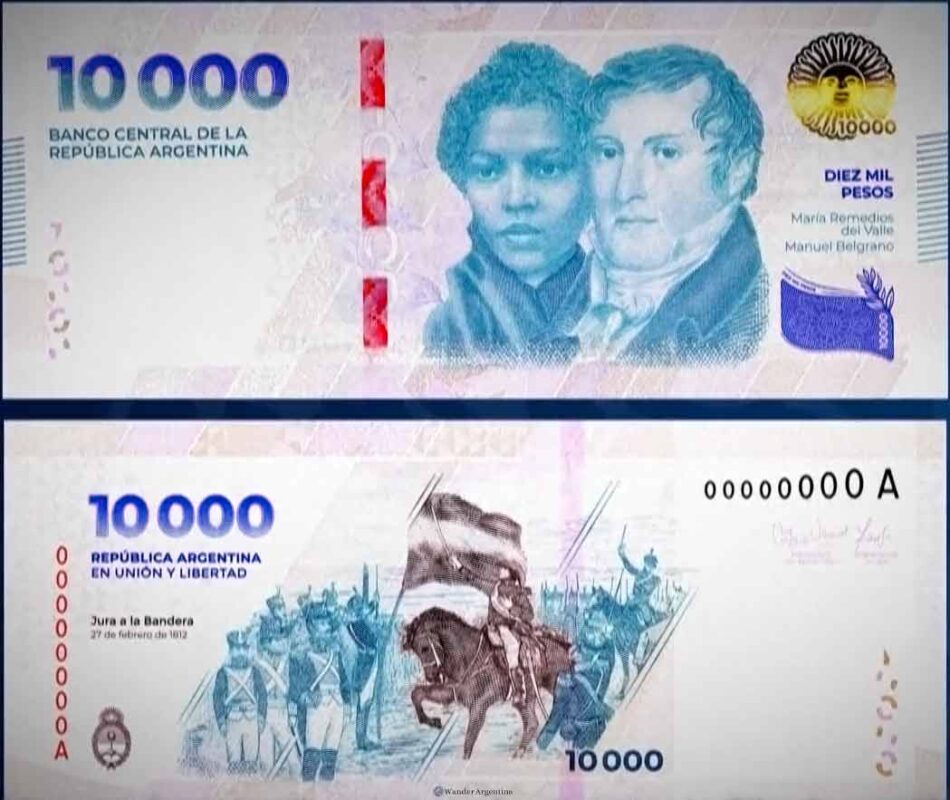
One year later in 2024, to relieve of everyone a new $10,000 bill was introduced.
The Central Bank just skipped over creating a $5,000 bill.
That’s Argentina inflation for you — all that counting of money was slowing down lines at the grocery storee.
Pre-Travel Money Tip:
🚫 Do not exchange your foreign currency into Argentine pesos before arriving in Argentina. They probably won’t have it anyway but if available you will get the official rate
✅ Do bring USD cash and wait until you are in the city (if possible) to change money at the Blue Rate because you will need cahs
You can also try to pay for something at McDonald’s or Starbucks in the airport arrivals area with USD and get the change in pesos, but make sure to check the rate they give first.
It’s also possible to book airport pickup in advance to avoid the exorbitant ATM fees outlined below and later change Blue dollars or use Western Union to get a more favorable rate.
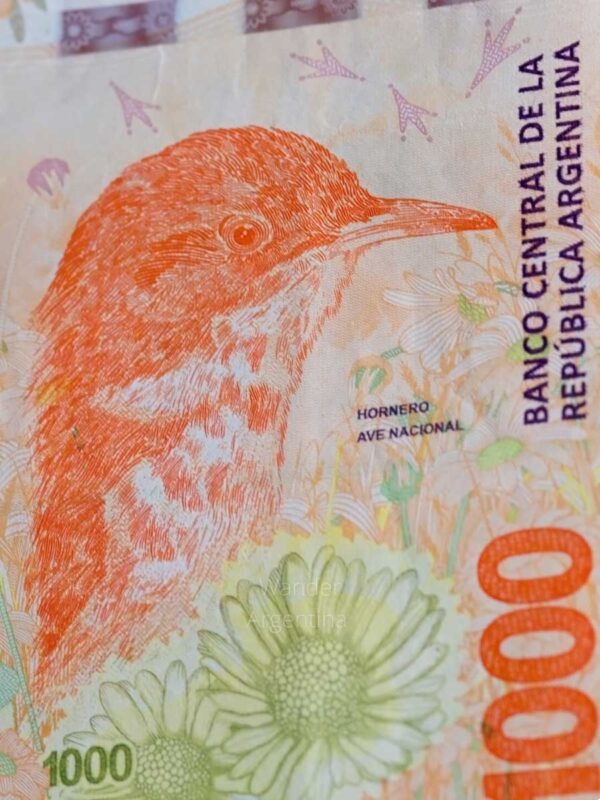
V&S Boutique Hostel is a place to stay that ticks all the boxes.
It’s reasonably priced, clean, and offers guests a wide range of activities.
It is also located in the thick of the action downtown — this could be either a plus or a minus, depending on what you’re after.
This post includes affiliate links. If you make a booking we receive a small commission at no extra cost to you ❤️.
A Laid-Back but Social Downtown Hostel
Most Buenos Aires hostels are gathered around the tango bars and steak houses of San Telmo, or the bars and clubs of Palermo, but the microcentro area offers a happy compromise.
The corner of Viamonte and Suipacha streets lies two blocks walking distance of the pedestrian thoroughfare of Florida and Galeria Pacificos, a shopping mall that contains the Borges Cultural Center.
It’s also two blocks away from the spectacular Teatro Colón, among the world’s most celebrated opera houses.
Transportation is no problem here with numerous bus stops and subway lines running nearby.
Getting to San Telmo from the V&S takes less than 30 minutes on foot, and is even quicker by public transport or by using one of the city’s free bikes.
Palermo is slightly further away but still easy to reach from here.
The only drawback of being based downtown is the noise and hustle of a typical working day, which confront you as soon as you step out the door.
If you can cope with that, you’re in a very convenient spot for a fun stay in Buenos Aires.

Discover Argentina’s Asado Tradition in a friendly, fireside atmosphere.
The Space: Peaceful but Social
Inside, the V&S is relaxed and comfortable.
Typical Argentine early 20th-century elegance is reflected in details such as the antique elevator, the cozy library and the French balconies and terrace overlooking a park.
The communal area is sunny and spacious, decorated with touches of rural Argentina.
It’s also dominated by a gigantic TV, perpetually alternating between movies and sports, depending on who has wrestled control of the remote.
V&S offers all the standard features you would expect from a good hostel.
The price of your room includes a buffet breakfast (until 10:30 am), introductory Spanish and tango lessons, and personal lockers (bring your own lock for extra security).
Internet access and laundry are available for a small fee.
The staff helps arrange trips to the usual attractions such as football games, theater and tango shows.
The management also finds a good balance between encouraging a peaceful environment for guests who need their rest, while providing plenty of opportunities to socialize.
Group dinners are arranged a couple of times a week they can get guests discounts at various recommended nightspots every night of the week.
On Thursday, Friday, and Saturday nights the hostel puts on live shows highlighting Argentine genres of music, such as tango and national rock, giving guests the chance to experience the local scene.
Rates vary slightly depending on season and length of stay, but the cheapest option is the 8-person room.
Four-bed rooms, with either external or internal bathrooms, are a slightly more expensive alternative.
Private rooms for solo travelers or couples with a small balcony and private bathroom are also available.
A huge plus is that all rooms have air conditioning and heating, an important feature during Buenos Aires’ chilly winters and muggy summers.
If you’re looking for a downtown hostel in Buenos Aires, head to V&S for a more relaxed environment.
If partying is on the agenda, check out the nearby Milhouse Hostel on Avenida de Mayo.
Book V&S Hostel Online
Viamonte 887 (corner of Suipacha)
Retiro/Downtown
As it is, if someone sends themselves US$100 via Western Union, it’s possible to be given the total in one hundred pesos, or, more likely, two hundred bills.
This means a relatively small amount of money could entail carrying stacks of cash.
In an extreme — but possible scenario, if you exchange $100 USD for Argentine pesos at the rate of $1 USD = $1100 pesos, and you receive only 100 peso bills, you would recieve 1,100 bills.
It might be worth bringing a roomy money belt to try accommodate all that cash.
Why is Argentina’s Money Situation So Weird?
In the 1990s the peso was pegged to the dollar, one-to-one.
After Argentina’s disastrous financial crisis of 2001, it was no longer pegged to the dollar and since then has lost considerable purchasing power as the government prints new money.
Now, one U.S. dollar is worth well over 300 hundred pesos.
In more recent economic developments, in 2021 Argentina’s inflation rate reached over 58% according to Bloomberg.
In 2022, the economy minister resigned and then the peso hit a record high against the dollar.
Due to the inflationary nature of the Argentine peso, locals prefer to buy and save in foreign currency.
This is because Argentine pesos lose significant purchasing power sitting in the bank due to inflation.
But the government severely limits the amount of foreign currency that locals can purchase.
Most locals can’t purchase foreign currency legally at all.
Argentines with U.S. dollar accounts can legally purchase only US$200 a month.
These restrictions create a huge underground demand for foreign currency since locals also have no way to get their hands on any reasonable amount of foreign currency through official channels.
Euros, although falling against the U.S. dollar are particularly strong against the peso.
Travelers who want to get the best exchange rate with the least hassle should come to Argentina with coveted U.S. dollars, Euros or Reales to exchange for Argentine pesos at underground exchange houses.
Using a money transfer service is also a popular option.
Sometimes money transfer services provide a higher rate than black market cash exchange, but it also fluctuates day-to-day.
Tips for Dealing with Cash in Argentina
Due to the quickly devaluating currency, it’s a long-held Argentine custom to round up or down, at one time a few centavos — today a few pesos — to avoid fiddling with change.
Almost every cashier visitor encounters will request exact change.
So if an item costs AR$920 and you hand over a one thousand peso bill they will ask, ‘¿Tenes viente?’ (using the ‘voseo’ form, characteristics of Argentine Spanish.)
If you say ‘No’ they will grudgingly hand over the change.
If it’s a smaller amount and the change is only five or ten pesos, it’s not uncommon for the grocer to hand over a piece of hard candy in lieu of your small change.
Since the currency is so devalued, travelers will probably end up carrying a lot of small change and bills after spending a day around town.
But oddly, small change can still sometimes be scarce for cashiers and taxi drivers, so it’s still a good idea to hold on to that small change to avoid ending up with a pocketful of candy.
Argentina’s historical small change problem has been alleviated somewhat with the introduction of smart cards such as the electronic SUBE card for public transportation to ride Buenos Aires’ subway.
Taxi drivers are notorious for not having much change, another reason they seem to be losing out to ride sharing services such as Cabify and Uber.
(☛ Also be aware of the bank note switch scam if paying with 1,000 peso bills).
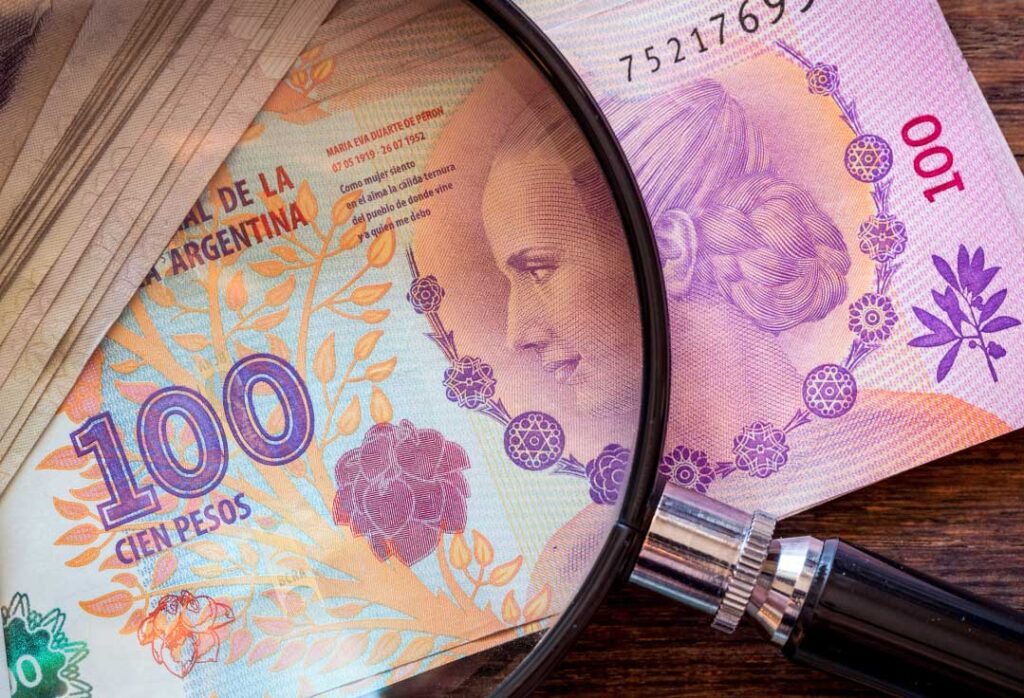
Which Bills to Bring for Blue Dollar Exchange
When coming to Argentina, it’s best to have crisp, new US$100 bills or Euros to exchange on the black market.
Smaller bills will fetch less on the exchange market.
Euros and Reales are also exchanged on the black market.
Beware that outside of Buenos Aires it can be more difficult to exchange Euros and Reales, so it may be a good idea to come with dollars or exchange them before traveling to more remote destinations.
Five, ten and twenty dollar bills will not be readily accepted by money changers.
It may be possible to use them in a store to get change in pesos or exchange them for a lower rate.
Bring ‘Big-Headed’ Benjamins
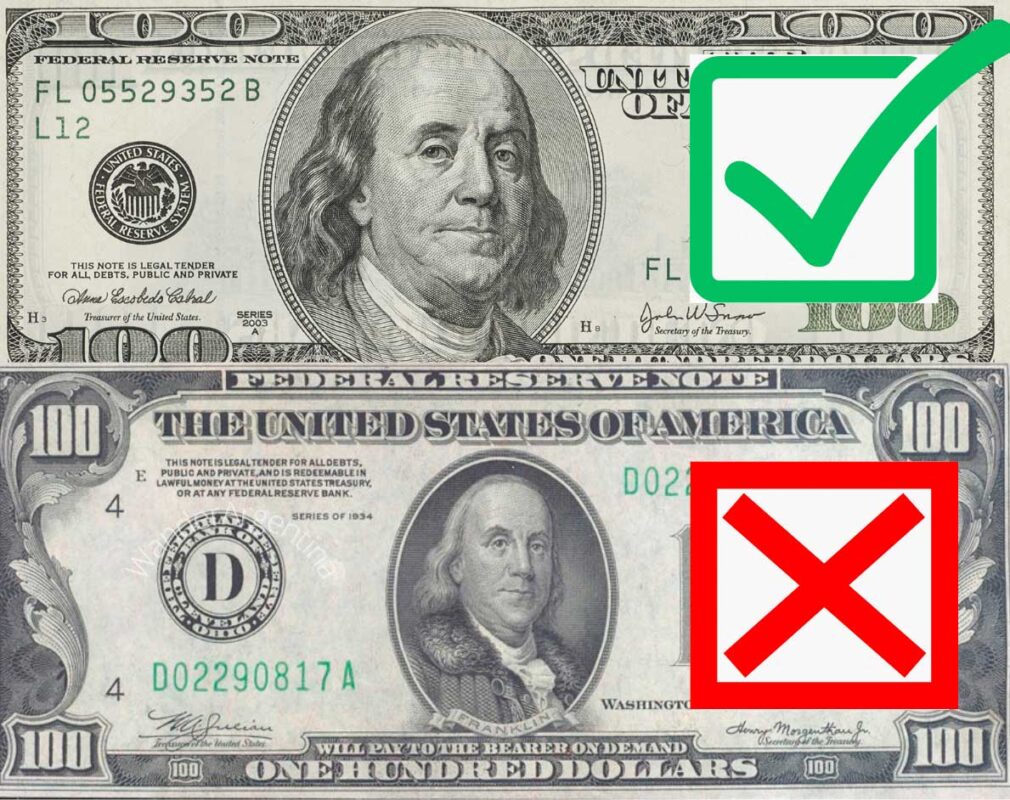
A peculiarity in Argentina (and much of South America) is that the preferred $100 dollar bills are those with a ‘big-headed’ Benjamin Franklin.
Older bills $100 bills (pre 1993) have a smaller head and will fetch 3-5% less exchanging on the black market.
No amount of explaining that the bill is worth equal value in the United States will change that.
This goes back to a rumor that the U.S. Federal Reserve was going to take the smaller-headed bills out of circulation or the possibility that they may in the future.
People in Argentina keep their money ‘under the mattress’ for a long time and want to be sure they have legal tender when they eventually need to convert it.
Aside from making sure to bring the right Benjamins, bills that are torn, worn or stained will also be rejected or fetch less on the underground currency exchange market.
Changing Money in Argentina
Bringing United States dollars to Argentina to take advantage of the ‘blue dollar’ at least as a backup for transferring money is a good idea.
Although technically illegal, it’s common and not as sketchy as it sounds.
See our post that details how to exchange money exchange on the black market on Buenos Aires’ Florida Street.
If carrying a lot of cash feels unsafe, bring at least a few bills and then sign up for one of the money transfer services.
As described on our Money Transfer page, you can to send money to yourself from your banking account, debit or credit card and receive a favorable rate without fussing with the underground exchange.
This is a way to get pesos at the blue dollar/black market rate.
It is legal and safe, but not as reliable as cash.
Keep in mind that the money transfer services are only open during the week during business hours and may be hard to find outside the major cities, that’s why cash is a good backup.
It’s not uncommon for foreigners to be caught out without cash on the weekends and holidays, simply because Western Union had no money or was closed due to protests, a World Cup win 😁 or for vacation.
This is when having some foreign cash on hand can come in handy.
Dealing with Money While Traveling around Argentina
Argentina’s smaller cities may have anemic ATM reserves, Western Union that are chronically low on cash and long lines to access cash.
It’s a good idea to stock up on pesos in Buenos Aires before exploring the country because it may be hard to access larger amounts in the countryside.
Also carry dollars in case you run short.
‘Cuevas,’ where one can change money, operate in most major cities and you may meet locals who want to buy dollars, which allows you to cut out the middle man.
Relying on Western Union and ATMs to access cash while traveling around Argentina could lead to frustrating situations that waste your precious travel time.
Using Credit & Debit Cards 🛑
Credit cards are left for the end on this post because until recently foreigners tended to avoid using credit or debit cards at all, erm, costs.
It can be hard for people not accustomed to carrying cash to get used to this, but Argentina is definitely a cash economy for visitors.
But thanks to the new regulations put in place in late 2022, credit and debit cards now allow for whats called the ‘MEP rate’ (‘Electronic Means of Payment‘ in its Spanish acronym).
Those who pay accomodation, tours and large restaurants with these credit cards in Argentina will get this rate. Remember, it does not Apple to paying with a QR code such as Apple Pay.
If you get out of the tourist zone you will find many restaurants and stores do not accept credit cards, so carrying cash is still recommended.
Even before the parallel currency market returned, businesses frequently gave a better rate for paying ‘en efectivo‘ (cash) because of credit card transaction fees. This still holds true.
For convenience and safety’s sake it’s best just to carry enough cash around to cover small daily expenses.
Those who don’t want to fuss with money transfer services or changing money on the black market can pay for larger items with their credit card if willing to lose the difference to the Blue Rate.
The added benefit to this is that visitors are entitled to a refund on the 21% Value Added Tax (VAT) if making purchases at stores that are part of the Global Blue Argentina program, mostly multinational corporations. Keep the receipts to get the refund at the airport on the way out.
Using ATMs in Argentina: Costs & Fees 🛑
It’s always good to have a bank card and credit card on your travels and, in Argentina, tucked away somewhere as a backup in case of emergency.
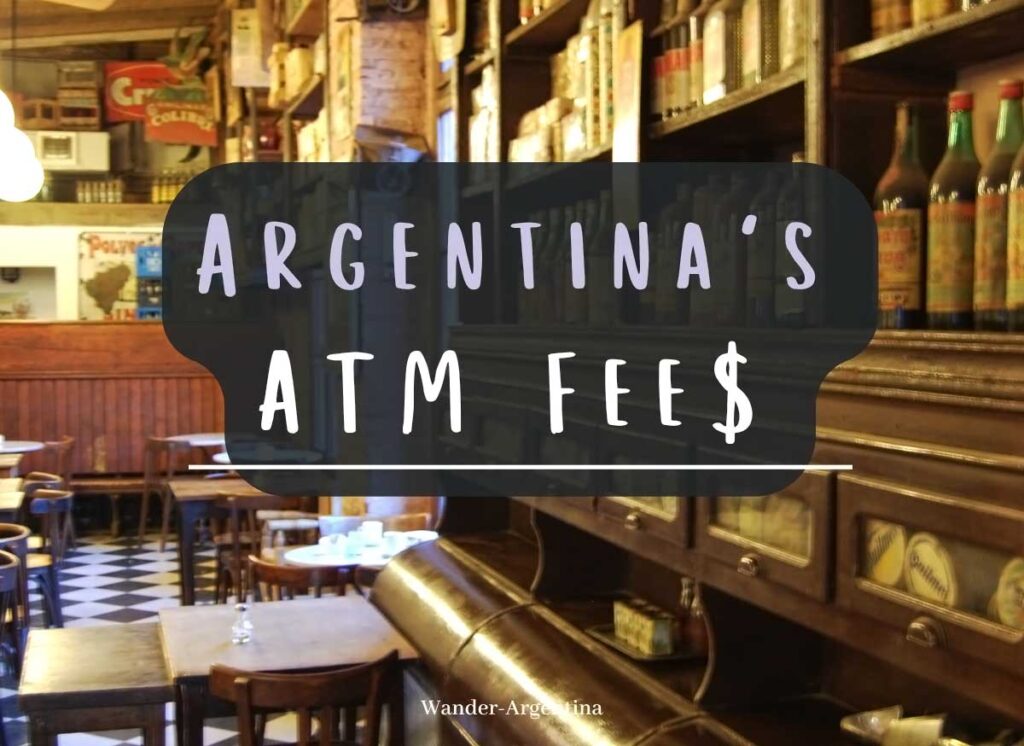
ATMs are abundant in most major cities and accept all types of debit and credit cards.
Even though travelers now get the MEP rate using their card, budget-conscience travelers to Argentina still avoid ATMs if adverse to losing money.
Argentina’s ATMs are know for their, ‘Low Withdrawals limits — High Fees.’
So when accessing money from a foreign bank account in Argentina up to twenty or thirty percent of your money is eaten by fees.
ATM withdrawals are limited to a maximum of about U.S. $82-$200 per transaction for most banks, and only two withdrawals per day are permitted, so using ATMs proves impractical.
What’s worse is that the low withdrawal amounts are combined with an ATM fee of approximately US$10 or more per transaction.
This means that on top of getting the ‘MEP’ rate (if their credit card issues a refund) visitors who use ATM’s also pay somewhere around 10% just to use bank machines here — and that’s withdrawing as much as possible at a time.
Even when the ‘Blue Dollar‘ market died down under the previous administration (who regularized the money situation), visitors sought out alternate options such as money transfer services and cryptocurrency to access their money from abroad to avoid Argentina’s high ATM fees.
Considering the difficulty and costs of using banks in Argentina it is understandable that visitors go to the black market to get their hands on some pesos.
While technically ‘illegal,’ the black market trade of currency is common in Argentina and there are no cases of foreigners getting in trouble with the law for trading money with a private entity.
Frequent travelers may want to find a home bank that reimburses transactions.
As a backup, savvy travelers would be smart to open a checking account with a bank back home that refunds ATM fees and doesn’t charge foreign currency fees, if available.
-In the U.S., Charles Schwab and some credit unions refund ATM fees, while others such as Capital One and USAA refund a limited amount.
-Australians should look into Citibank Plus, an ING Orange Everyday account and Schwab checking.
-Canada doesn’t have many good options for banks that refund ATM fees, but try out ScotiaBank/Tangerine-ING, HSBC Premier or TD Bank. Tangerine is an online bank that can be useful for Canadians who want to collect their pension while in Argentina.
-In the UK most banks do not refund the banking fees, but Nationwide has some of the best rates. The mobile-based Starling Bank is also worth investigating.
(None of the above suggestions are sponsored, this is just based on word on the street)
Many of the checking accounts that refund international ATM fees have certain requirements, so you’ll have to figure out what works for your individual situation.
Regardless of your home bank, if you absolutely have to use your bank card in Argentina, to get charged as little as possible withdrawing money try to use ATMs that are on your home network.
The Argentine national bank mentioned above, Banco de la Nación (which is on the LINK system, shown by a green sign saying ‘Link’) has lower withdrawal fees at its ATMs than the private banks.
To be on the safe side, (➡️ in case you don’t read this article about common scams and fall victim to the ‘bird poop trick’) carry two different bank cards, kept in different places, during your stay.
When using ATMs beware that sometimes they are slow to spit the card back out at the end of the transaction.
Many a traveler has withdrawn money and walked away, accidentally leaving their card in the machine.
If that happens, you can try to go back to the bank the next day to retrieve it. They refill the ATMs between 2-3 p.m.
If it’s the weekend, you can try to go back the next working day, but it may take a miracle to get it back at that point.
Using Checks in Argentina 🛑
Those wondering if checks might be a good alternative option to having to carry cash will be disappointed.
Traveler’s checks are, at best, a total headache and at worse virtually useless in most of Argentina. One reliable place to cash them is at one of the three American Express offices in Buenos Aires, but there are more convenient options than using traveler checks these days.
Personal checks are virtually unheard of in Argentina, it’s even illegal to send them through the mail.
Leave your personal checkbook at home, it will do you no good in Argentina.
➡️ Read our post about the Current Exchange Rates and compare the live Official, Blue Dollar, Western Union rates on our currency converter
➡️ Read our post on using Money Transfer Services such as Western Union or Remitly to get the ‘Blue Rate’. Get a credit of $20 on your first transaction!
